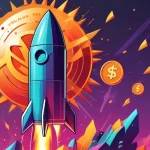Ethereum’s 10th Anniversary: NFT Torch and 2025 Market Surge Ignite Celebration

Ethereum’s 10th Anniversary: Symbolic NFT Torch Lights Up Amid 2025 NFT Market Surge
Ethereum has hit a decade of decentralized disruption, and it’s marking the occasion with a fiery digital tribute—a symbolic NFT torch passed through its global community. Announced on July 21, 2025, this celebration not only honors ten years of innovation but lands smack in the middle of a roaring NFT market revival, proving Ethereum still holds the crown in the crypto ecosystem.
- Community Flame: Ethereum Foundation launches “The Ethereum Torch” NFT, relayed between wallets until July 30, 2025, before a symbolic burn and free commemorative mint.
- NFT Market Roars: Ethereum-based NFTs hit $75 million in weekly sales, driving a $110 million cross-chain surge in 2025.
- Price Ignition: Ethereum’s value spikes nearly 50% since early July, fanning the flames of ecosystem optimism.
The Ethereum Torch: A Symbol of Decentralized Spirit
Let’s get straight to the heart of this milestone. The Ethereum Torch isn’t just another NFT drop for speculators to flip. It’s a digital emblem of the coders, creators, and contrarians who’ve turned Ethereum into a juggernaut since its 2015 debut. Starting with co-founder Joseph Lubin, also the brain behind ConsenSys, this unique non-fungible token shifts to a new community member’s wallet every 24 hours until July 30. It’s a virtual relay race, showcasing the borderless, permissionless ethos that defines blockchain tech. On the final day, the torch gets “burned”—destroyed on-chain in a dramatic gesture—closing one chapter and opening another. After that, a new commemorative NFT will be free to mint for anyone, prioritizing inclusion over profit. For more on this unique initiative, check out the symbolic NFT torch celebration.
“The Torch is an NFT honoring the people and values that have shaped Ethereum’s first decade and will help build its future.” – Ethereum Foundation
Unlike the speculative circus that often surrounds NFTs, you won’t find this torch on marketplaces like OpenSea. That’s by design—a rare middle finger to the greed that’s tainted much of the crypto space. Instead, it’s all about community, not cash grabs. For those just dipping their toes into crypto, NFTs (non-fungible tokens) are unique digital assets logged on a blockchain like Ethereum, representing everything from art to virtual swag. Ethereum dominates this arena thanks to its smart contracts—self-executing code that cuts out middlemen by automating agreements. This torch initiative isn’t about trading; it’s a nod to the cultural and ideological roots of a network that’s redefined what decentralization can do. Dive into the background of this pioneering blockchain with this detailed history of Ethereum.
NFT Market Revival: Real Momentum or Another Mirage?
This anniversary bash couldn’t have timed better with the NFT market shaking off its 2024 slump. After trading volumes tanked 18% last year, recent numbers are turning heads: total weekly NFT sales across all blockchains hit $110 million, the highest in six months. Ethereum-based NFTs lead the charge with a hefty $75 million, a staggering 300% leap in just two weeks. Bitcoin-based NFTs clocked $25.6 million (up from a measly $11 million in early July), while Polygon—a layer-2 fix that makes Ethereum transactions faster and cheaper by offloading them from the main network—saw a minor dip. Meanwhile, Ethereum’s own price soared nearly 50% since July 6, 2025, peaking at $3,814 before easing back. When ETH surges, the ecosystem often catches fire, but let’s not get starry-eyed—is this genuine revival or just another hype bubble waiting to burst? Explore the latest data on Ethereum NFT sales surges for deeper insights.
The spotlight’s also on big-ticket NFT collections fueling this frenzy. CryptoPunks, one of Ethereum’s pioneer projects, saw a whale shell out $8.5 million for 48 tokens in one go, nudging floor prices up 16%. Pudgy Penguins waddled into second place for trading volume, outshining even Bored Ape Yacht Club offshoots with a daily haul of $5.7 million. Even more eyebrow-raising is the institutional interest creeping in—Canary Capital filed for an ETF tied to Pudgy Penguins’ PENGU tokens through Cboe BZX. If the SEC gives a nod, NFTs could infiltrate mainstream investment portfolios, though regulatory buzzkills could easily douse that flame. Learn more about this development with the latest updates on the Pudgy Penguins ETF filing.
But let’s pump the brakes on the hype train. The NFT space is still a chaotic mess of volatility. The 2021-2022 rollercoaster taught us that skyrocketing values can crater overnight, leaving latecomers holding digital dust. Most NFT projects remain little more than glorified lottery tickets with abysmal odds. Still, as Yat Siu of Animoca Brands points out, Ethereum’s NFT ecosystem isn’t just about money—it’s a cultural force, weaving status and community into the digital fabric. Get a broader perspective on these trends via this analysis of the 2025 NFT market rally.
“NFTs are the backbone of the Ethereum cultural economy, much more than just financial, it’s about culture, status, and ultimately belonging.” – Yat Siu, Chairman of Animoca Brands
Ethereum at 10: A Legacy of Bold Moves and Bumps
To grasp why this torch and market surge carry weight, let’s rewind through Ethereum’s wild decade. Launched in 2015 by Vitalik Buterin and a band of tech rebels, Ethereum didn’t settle for being Bitcoin’s shadow. While I’ll always argue Bitcoin is the gold standard for decentralized money—period—Ethereum blazed its own trail with smart contracts, powering decentralized apps (dApps), DeFi protocols, and the NFT craze. Its journey’s been a saga of highs and lows: the 2016 DAO hack exposed early flaws (spawning Ethereum Classic after a controversial rollback), the 2020 DeFi summer unleashed yield farming madness, and the 2022 Merge shifted it from energy-hogging mining to a greener proof-of-stake setup. Today, Ethereum underpins a vast ecosystem, from stablecoins to virtual realms.
Yet, it’s not all smooth sailing. Gas fees—the cost to process transactions on Ethereum—still bite hard during peak traffic, even with layer-2 solutions like Polygon easing the load. Rivals like Solana, with blistering speed and rock-bottom costs, are luring developers and NFT creators away. Environmental gripes persist post-Merge, though they’re overblown compared to Bitcoin’s mining thirst. And while moves like the Pudgy Penguins ETF scream mainstream potential, they also paint a target for regulatory hawks itching to leash crypto’s wild spirit. Ethereum’s strength is its sprawling versatility, but that can also be its Achilles’ heel—juggling so many use cases risks losing focus. Join ongoing conversations about these topics in this Ethereum community discussion.
Bitcoin and Ethereum: Allies in Disruption?
Let’s throw on my Bitcoin maximalist cap for a hot second and play devil’s advocate. Should Ethereum be chasing shiny toys like NFTs and dApps while Bitcoin stays laser-focused on being unassailable, censorship-resistant money? Hardcore BTC purists might scoff, saying Ethereum’s sprawling complexity breeds bugs, hacks, and creeping centralization—look at the endless DeFi rug pulls draining millions. Why not let Bitcoin be the store of value and leave the experimental sandbox to smaller chains? It’s a valid jab, but here’s the flip side: Ethereum isn’t Bitcoin’s enemy; it’s a partner in crime. Bitcoin safeguards wealth; Ethereum tests the edges of what decentralization can build. Flawed as they are, NFTs and DeFi push boundaries Bitcoin shouldn’t have to touch. Together, they fuel the fight for privacy, freedom, and flipping the bird at centralized power. That’s effective accelerationism—e/acc—in action: full speed ahead, flaws and all. For a closer look at specific NFT trends, see the latest CryptoPunks trading volume data for 2025.
The Road Ahead: Can the Torch Keep Burning?
As the Ethereum Torch makes its way through wallets worldwide, it’s a moment to salute ten years of grit and disruption. This isn’t just a birthday for a blockchain; it’s a gut check on whether the principles it stands for—decentralization, inclusivity, rebellion against the old guard—can endure another decade of hype, crackdowns, and tech upheaval. Will NFTs morph into tools with real utility, or stay playthings for crypto’s high rollers? Can Ethereum fend off leaner, meaner competitors while scaling for the masses? And above all, will the flame of freedom outshine the pull of profit and control? For now, let’s toast Ethereum’s first decade, fully aware the path forward is a gauntlet of promise and peril. Ponder the future relevance of NFTs with perspectives shared on the ongoing significance of Ethereum NFTs in 2025.
Key Questions and Takeaways on Ethereum’s Decade Milestone
- What’s the deeper meaning behind the Ethereum Torch NFT?
It represents Ethereum’s decentralized heartbeat, celebrating ten years of global impact by passing through community wallets before a symbolic burn and a free commemorative mint for all. - Why keep the Ethereum Torch off trading platforms like OpenSea?
The Ethereum Foundation’s choice underscores its value as a community tribute, not a speculative asset, pushing back against the profit-obsessed vibe of many NFT projects. - How does Ethereum’s 2025 price jump relate to the NFT boom?
A nearly 50% price climb since early July 2025 aligns with a 300% spike in Ethereum-based NFT sales to $75 million weekly, hinting at renewed investor confidence—though causality isn’t certain. - What’s the significance of institutional moves like the Pudgy Penguins ETF?
It suggests NFTs could gain traction as legitimate investments, bridging crypto with traditional finance, but SEC skepticism might slam the brakes on such integration. - How does Ethereum’s NFT lead stack up against other blockchains in 2025?
Ethereum’s $75 million in weekly NFT sales towers over Bitcoin’s $25.6 million and Polygon’s fading numbers, solidifying its role as the cultural epicenter for digital collectibles. - What hurdles does Ethereum face after a decade of innovation?
Lingering gas fee woes, competition from swift chains like Solana, and regulatory shadows from institutional interest threaten its reign, despite strides like layer-2 scaling and the Merge. - How do Ethereum and Bitcoin mesh in the crypto uprising?
Bitcoin anchors decentralized wealth, while Ethereum experiments with smart contracts, NFTs, and DeFi, stretching blockchain’s disruptive potential—united, they champion freedom and privacy.



